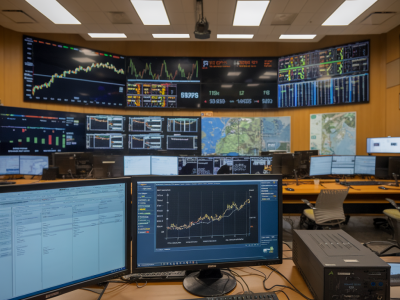
As I delve deeper into the ever-evolving intersection of energy and sustainability, I keep coming across a peculiar and fascinating organism that is sparking a wave of innovation: algae. These tiny, seemingly unremarkable plants might just hold the key to tackling one of our planet’s most pressing challenges—carbon capture. When we talk about green innovation, this is the type of breakthrough that rejuvenates my enthusiasm for what humanity can achieve in our quest to mitigate climate change.
What Makes Algae Unique for Carbon Capture?
At first glance, algae might not seem remarkably different from other plants. However, their unique characteristics make them a potential unsung hero in the fight against climate change. Algae are incredibly efficient at photosynthesis, the process by which they convert carbon dioxide (CO2) into oxygen and biomass. In fact, certain species of algae can absorb up to 10 times more CO2 than terrestrial plants like trees.
Why is this significant? The ability of algae to rapidly consume CO2 means they could effectively serve as a "natural carbon vacuum," especially when integrated into industrial systems. Moreover, algae grow rapidly and can double their biomass within a day or two under optimal conditions, making them a renewable resource for sustainable applications. Unlike forests, algae systems require less land and fewer resources to thrive, which positions them as a viable solution in densely populated or resource-scarce regions.
How Is Algae Being Integrated Into Carbon Capture Technologies?
It's one thing to acknowledge algae's potential, but how are industries actually employing this powerhouse in real-world applications? Here are some intriguing examples where algae has taken center stage:
- Industrial Carbon Capture Systems: Companies like CarbonCapture Inc. are exploring algae-based reactors called "bioreactors" that can be installed near factories and power plants. These systems use algae to absorb CO2 directly from industrial emissions, converting it into oxygen and biomass. This not only reduces greenhouse gases but also creates valuable byproducts.
- Algae Cultivation for Biofuels: Many experts consider algae-derived biofuels a promising solution for the energy transition. By capturing CO2 in algae ponds or bioreactors, companies like ExxonMobil are producing biofuels that could one day replace fossil fuels in aviation, marine transport, and heavy industries.
- Innovative Building Materials: Some sustainable architectural designs are incorporating algae systems into their buildings. For example, Germany’s "Bio Intelligent Quotient" (BIQ) House has an algae-powered façade that captures CO2 and provides energy for the building.
These applications go beyond theoretical concepts and are already being tested or implemented in various parts of the world. Beyond carbon capture, algae systems often come with the added benefit of producing byproducts—like oils, proteins, or fertilizers—that can be used in diverse industries.
What Are the Challenges of Using Algae for Carbon Capture?
As much as I want to celebrate this groundbreaking innovation, it’s important to recognize that the road to widespread adoption of algae-based carbon capture systems isn’t without hurdles. Here are a few challenges standing in the way:
- High Operational Costs: Setting up and maintaining algae cultivation systems can be expensive. This includes the cost of bioreactors, nutrient supplies, and precise lighting conditions required for optimal algae growth.
- Scalability Issues: While algae systems work efficiently on a small scale, scaling these solutions to handle millions of tons of CO2 emissions poses engineering and logistical challenges.
- Competition for Resources: Growing algae requires water, nutrients, and sometimes energy, raising concerns about sustainability when resources are already stretched thin in some regions.
Despite these obstacles, ongoing research and technological advancements are aiming to address these issues. For instance, some start-ups are exploring the use of wastewater as a nutrient source for algae, tackling both resource consumption and water pollution simultaneously.
What About the Environmental and Economic Benefits?
Integrating algae into carbon capture solutions doesn't just make environmental sense—it could also prove economically advantageous. One of my favorite aspects about algae technologies is their circular potential. Unlike traditional carbon capture systems that often incur high costs without generating returns, algae can provide valuable co-products like biofuels, protein-rich animal feed, or even cosmetics. These byproducts create opportunities for revenue streams, potentially offsetting implementation costs and making algae systems more attractive to both investors and policymakers.
Moreover, algae systems can contribute to other environmental goals. For example, algae ponds can help purify wastewater, absorbing nutrients like nitrogen and phosphorus that otherwise contribute to water pollution. This multi-functionality makes algae a truly versatile tool in our sustainability arsenal.
Is It Time to Invest in Algae Innovation?
As someone who spends a lot of time examining global trends and future technologies, I can't help but feel excited about what algae could do for our planet. However, large-scale adoption will require more than just scientific research; it will need robust policy frameworks, financial incentives, and widespread public awareness. Governments, NGOs, and private investors must recognize the potential of algae and actively support its development.
Several countries are already stepping up. The European Union, for instance, has funded multiple projects exploring algae-based carbon capture under its Horizon Europe program. Meanwhile, in the United States, companies working on algae-related technologies are benefiting from federal backing under tax credits and clean energy grants.
So, is algae the secret weapon we’ve been waiting for in carbon capture technologies? It’s still too early to make definitive claims, but one thing is certain: the potential is extraordinary, and the momentum is building. If we can overcome the challenges and foster widespread adoption, algae could very well transform how we approach carbon capture and, ultimately, our planet's future.

